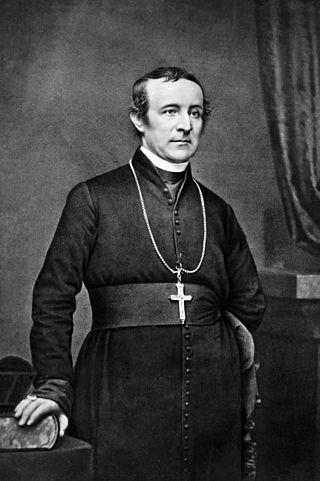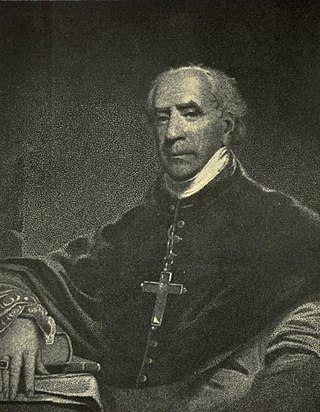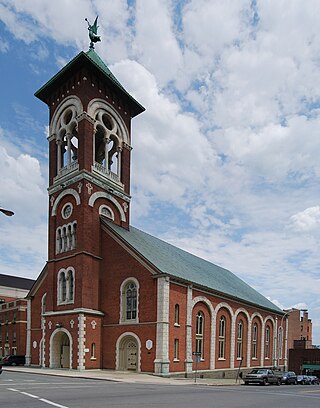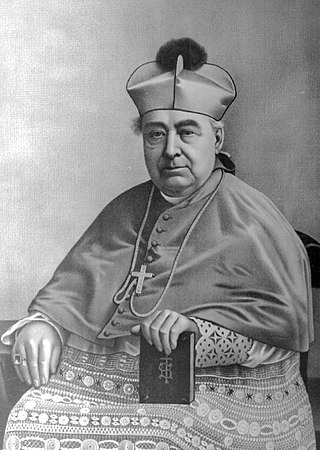
John McCloskey was an American senior-ranking prelate of the Catholic Church. He was the first American-born Archbishop of New York from 1864 until his death in 1885, having previously served as Bishop of Albany (1847–1864). In 1875, McCloskey became the first American cardinal. He served as the first president of St. John's College, now Fordham University, beginning in 1841.

John Joseph Hughes was a prelate of the Roman Catholic Church in the United States. He was the fourth Bishop and first Archbishop of the Archdiocese of New York, serving between 1842 and his death in 1864. In 1841, he founded St. John's College, which would later become Fordham University.

The Roman Catholic Metropolitan Archdiocese of Philadelphia is a Latin Church ecclesiastical territory or diocese of the Catholic Church in southeastern Pennsylvania – in the United States. It covers Philadelphia, the nation's sixth-most populous city, and five Pennsylvania counties: Bucks, Chester, Delaware, Montgomery, and Philadelphia. The diocese was erected by Pope Pius VII on April 8, 1808, from territories that has previously been part of the Archdiocese of Baltimore.

John Nepomucene Neumann was a Catholic immigrant from Bohemia. He came to the United States in 1836, where he was ordained, joined the Redemptorist order, and became the fourth Bishop of Philadelphia in 1852. In Philadelphia, Neumann founded the first Catholic diocesan school system in the US. Canonized in 1977, he is the only male US citizen to be named a saint.

Francis Patrick Kenrick was an Irish-born prelate of the Roman Catholic Church who served as the third Bishop of the Diocese of Philadelphia (1842–1851) and the sixth Archbishop of the Archdiocese of Baltimore (1851–1863).

Dennis Joseph Dougherty was an American prelate of the Catholic Church. He served as Archbishop of Philadelphia from 1918 until his death in 1951, and was made a cardinal in 1921. He was Philadelphia's longest-serving archbishop and its first cardinal.

Michael Francis Egan was an Irish, later American, prelate of the Roman Catholic Church. He was born in Ireland in 1761, and joined the Franciscan Order at a young age. He served as a priest in Rome, Ireland, and Pennsylvania and became known as a gifted preacher. In 1808, Egan was appointed the first Bishop of Philadelphia, and held that position until his death in 1814. Egan's tenure as bishop saw the construction of new churches and the expansion of the Catholic Church membership in his diocese, but much of his time was consumed by disputes with the lay trustees of his pro-cathedral, St. Mary's Church in Philadelphia. He died in Philadelphia, probably of tuberculosis, in 1814.

Henry Conwell was an Irish-born Catholic bishop in the United States. He became a priest in 1776 and served in that capacity in Ireland for more than four decades. After the Pope declined to appoint him Archbishop of Armagh, the diocese in which he served as Vicar General, he was instead installed as the second Bishop of Philadelphia in 1819.

The Archdiocese of Newark is a Latin Church ecclesiastical jurisdiction, or archdiocese, of the Catholic Church in northeastern New Jersey in the United States.

Thomas James Conaty was an American prelate of the Catholic Church. He served as rector of the Catholic University of America (1896-1903) and Bishop of Monterey-Los Angeles (1903-1915).

Fray José Servando Teresa de Mier Noriega y Guerra was a Roman Catholic priest, preacher, and politician in New Spain. He was imprisoned several times for his controversial beliefs, and lived in exile in Spain, France and England. His sermons and writings presented revisionist theological and historical opinions that supported republicanism.

Camillus Paul Maes was a Belgian-born American prelate of the Catholic Church. He served as the third Bishop of Covington from 1885 until his death in 1915. He remains the longest-serving bishop of the diocese and, during his 30 years in office, he was most notably responsible for building the current Cathedral Basilica of the Assumption.

St. Mary's Church is a Roman Catholic house of worship on Lodge Street in downtown Albany, New York, United States. It is a brick structure with an Italian Romanesque Revival exterior. Built in the 1860s, it is the third church to house the oldest Catholic congregation not only in the city, but in all of upstate New York. In 1977, St. Mary's Church was listed on the National Register of Historic Places; it is also a contributing property to the Downtown Albany Historic District, listed several years later.

Francis Xavier Gartland was an Irish-born American prelate of the Roman Catholic Church. He served as the first bishop of the Diocese of Savannah, covering Georgia and Eastern Florida, from 1850 until his death in 1854.

William O'Hara was an Irish-born American prelate of the Catholic Church. He was the first bishop of the Diocese of Scranton in Pennsylvania, serving from 1868 until his death in 1899. He founded St. Thomas College in 1888.

Ignatius Frederick Horstmann was an American prelate of the Roman Catholic Church. He served as bishop of the Diocese of Cleveland in Ohio from 1892 until his death in 1908.
The Church of St. Mary is a Roman Catholic parish church under the authority of the Roman Catholic Archdiocese of New York, located in Wappingers Falls, Dutchess County, New York. It was canonically established in 1845.
Adolphus Louis de Barth Walbach, commonly known as Louis de Barth, was a Roman Catholic priest in Pennsylvania and Maryland. Born and raised in Alsace, he emigrated with his noble family to the United States during the French Revolution. He spent the rest of his life as a priest there, mostly at Conewago Chapel in rural Pennsylvania. After the Bishop of Philadelphia died in 1814, de Barth temporarily led the diocese as apostolic administrator until a new bishop arrived in 1820. After several years at a German-speaking Baltimore parish, he retired to Washington, D.C., in 1841 and died there three years later.

William Matthews, occasionally spelled Mathews, was an American who became the fifth Roman Catholic priest ordained in the United States and the first such person born in British America. Born in the colonial Province of Maryland, he was briefly a novice in the Society of Jesus. After being ordained, he became influential in establishing Catholic parochial and educational institutions in Washington, D.C. He was the second pastor of St. Patrick's Church, serving for most of his life. He served as the sixth president of Georgetown College, later known as Georgetown University. Matthews acted as president of the Washington Catholic Seminary, which became Gonzaga College High School, and oversaw the continuity of the school during suppression by the church and financial insecurity.

Richard Worsam Meade was an American merchant and art collector, and the father of Civil War General George Gordon Meade. After growing up in his father George Meade's shipping business, he became successful in his own right in the American–Spanish trade. Meade lived in Cadiz, Spain, from 1803 to 1820, and was the U.S. naval agent there. He became quite wealthy and was one of the first American collectors of European art.

















